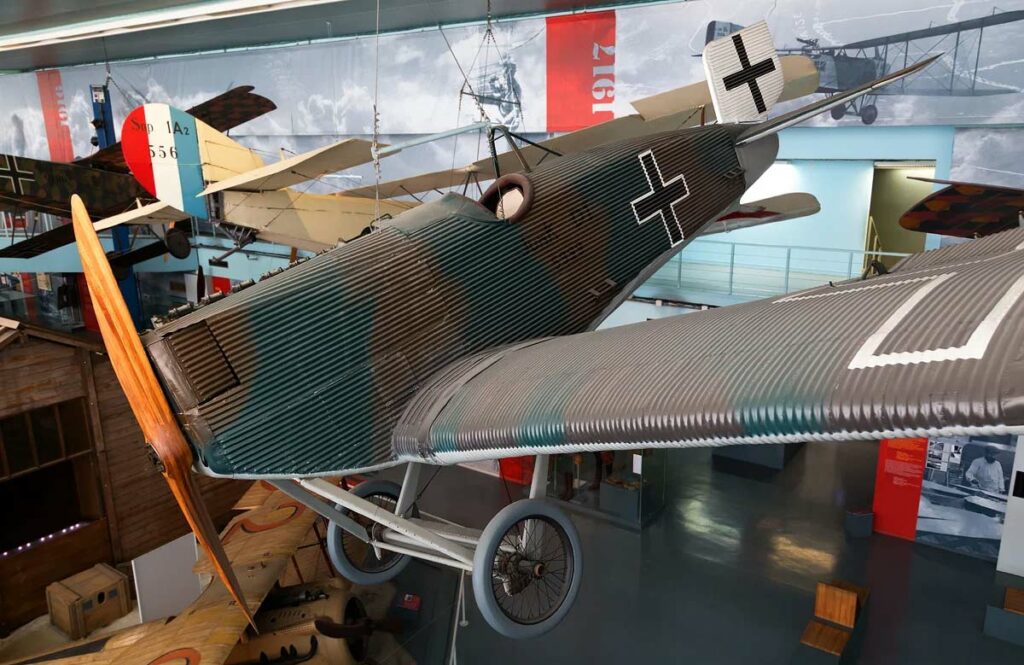Junkers D.I: WWI monoplane with all-metal construction, revolutionary design, and the moniker “Tin Donkey” for its durability. The Junkers D.I was a pioneering German fighter aircraft known for its all-metal construction and innovative design, which marked a significant departure from the wood and fabric biplanes of the era. As one of the first metal monoplanes, it set a standard for future aircraft developments.
The Junkers D.I stands as a testament to innovation in military aviation during World War I. It was a groundbreaking design that introduced all-metal construction, which would later become the industry standard.
History of the Development of the Junkers D.I
In the midst of World War I, the need for superior air superiority led to rapid advancements in aircraft technology. The German military required a robust, fast, and agile fighter to gain an edge in the air. Hugo Junkers, an advocate of all-metal aircraft, saw an opportunity to revolutionize aerial combat.
Junkers, an innovative engineer and founder of the Junkers company, had already introduced the J 1 in 1915, the world’s first all-metal aircraft. Building on this, Junkers’ team sought to develop a fighter aircraft with the same robustness but more suitable for the front-line combat role.
The Junkers D.I, known internally as the J 9, was the culmination of this effort. The program was launched with the aim to create a monoplane that could endure the rigors of combat, provide excellent performance, and offer a stable gun platform. Its first flight was on May 12, 1918, showcasing its revolutionary design.
Design of the Junkers D.I
The Junkers D.I was a trailblazer with its corrugated duralumin skin, a departure from the fabric-covered biplanes of the time. This design offered unmatched durability and a smoother aerodynamic profile, leading to better performance. Its length was approximately 7.25 meters (23 feet 9 inches), with a wingspan of 9.7 meters (31 feet 10 inches).
One of the key advantages of the Junkers D.I was its monocoque structure, which significantly increased its strength and rigidity. The cantilever wing design eliminated the need for external bracing wires or struts, which reduced drag and improved speed.
However, the use of metal increased the aircraft’s weight, demanding more powerful engines and careful management of the center of gravity. The advantages of durability and survivability often came at the cost of maneuverability.

Performance of the Junkers D.I
Powered by a BMW IIIa 6-cyl inline water-cooled engine delivering 185 horsepower, the Junkers D.I could achieve speeds of up to 170 km/h (105 mph), with a service ceiling of approximately 6,000 meters (19,685 feet). While its range was limited compared to reconnaissance aircraft, it was sufficient for the air-superiority role over the battlefield.
When compared to contemporaries like the Fokker D.VII biplane, the Junkers D.I offered a glimpse into the future of aircraft design with its metal construction and streamlined form. However, its heavier weight and lower maneuverability were notable when facing more nimble adversaries.
Military Use and Combat of the Junkers D.I
The Junkers D.I was equipped with two forward-firing 7.92mm LMG 08/15 machine guns. Its combat role was mainly as a high-altitude fighter, intercepting reconnaissance aircraft and balloons. It saw limited use before the end of the war, with only a small number being produced and deployed.
The competing aircraft of the era included the aforementioned Fokker D.VII, Sopwith Camel, and SPAD XIII. The D.I was not sold to other countries, and its use was confined to the latter stages of World War I. It was phased out shortly after the war, as aviation technology rapidly progressed, leading to newer designs.
The Junkers D.I was a remarkable aircraft for its time. Its pioneering all-metal design and monoplane configuration set it apart from its peers and established principles that would be used for decades to come. While it did not see extensive combat, its legacy is found in the standard it set for the future of aircraft manufacturing and design.
Back to the Warbirds section.